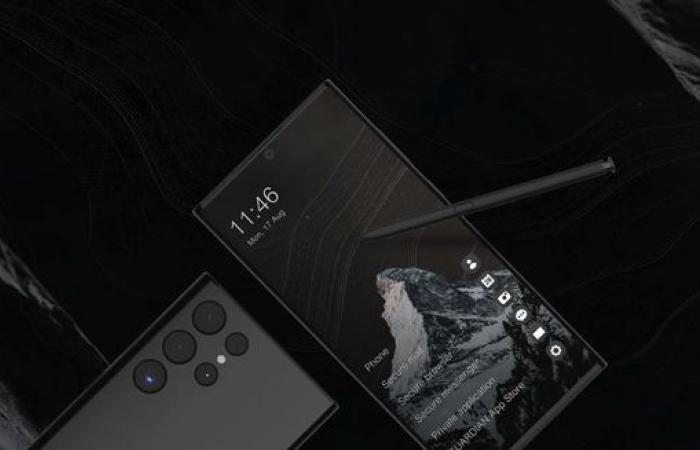Viola Amherd, Federal Councilor in charge of Defense.Image: watson
With Donald Trump once again at the head of the United States and Elon Musk on his team, space is experiencing a sudden resurgence of interest across the world. And the Swiss army also wants to make its place in the stars.
Othmar von Matt / ch media
At first glance, the smartphone looks like a completely ordinary Samsung: flat, square, with a black rim and five lenses on the back. There is also a stylus. But on closer inspection, the machine is perplexing. We discover a secure email box, a secure browser, secure text messages, a private Android operating system, a clean artificial intelligence called Lasa and even a separate App Store.
The Guardian smartphone can also connect to a satellite network.Image: Ruag MRO
Behind this laptop, there is Ruag MRO, the arms company and technical service provider for the Swiss army. She developed it in close collaboration with Wisekey, a Geneva company specializing in cybersecurity.
«Full control on devices »
Guardian, that’s its name, is inspired by a model produced in series and equipped with the Android operating system. It has undergone extensive treatment to secure it. According to Ruag spokesperson Kirsten Hammerich:
“We have removed any items that cannot be verified, do not involve productivity requirements, establish a connection with third parties, or send data to third parties.”
If a customer asks for a particular feature, they will get it through self-managed alternatives “in order to guarantee full control over the devices”. No one should be able to hack the smartphone, designed to meet the army’s “confidential” classification.
For now, Guardian remains in the prototype and testing phase. According to the company’s schedule, it will become the heart of secure communication for the army, police, authorities, border guards, firefighters, health services, civil protection and authorities in Switzerland.
The Swiss army plans to go into space
The new device can not only connect to 5G, but also to a network of satellites. “Guardian is a building block of a possible global satellite communications concept.”
Satellites, now a crucial point for the Swiss army. She is in fact planning to go into space and is working on a basic document which should be published soon. On the operational level, it wants to create a “Space” command, analogous to the “Cyber” command.
For that, satellites are essential. Defense Minister Viola Amherd knows this, as does the entire Federal Council. The Defense Capacity and Cooperation report dating from the end of January 2024 does not say anything else:
“Today, almost all complex military systems for positioning, time synchronization, communications, reconnaissance or weather forecasting depend on satellites.”
These grew and shrank “at full speed”. Consequence: they become accessible to small countries like Switzerland – “because prices are falling”.
Plummeting costs
We are indeed seeing a democratization of these systems. While the development of a model still cost 20 million a few years ago, today it only costs 300,000 francs, explains Carlos Creus Moreira, founder and CEO of Wisekey. The company has also been manufacturing satellites for three years through Wisesat and the Spanish company Fossa. In two years, this will even drop to 60,000 francsaccording to him. He adds:
“With containers ten times larger, the Starship rocket project can transport significantly more satellites. This reduces costs”
This democratization benefits the Confederation. Behind the scenes, Ruag MRO, the army, the Federal Armaments Office (Armasuisse) and – in close cooperation – the private company Wisekey are currently working on the subject.

The satellite developed by Wisesat and Fossa on behalf of Wisekey and the Swiss army. It will be launched into low Earth orbit by SpaceX on January 16 in California.Image: Wisekey
In the sights: the creation of a constellation of sovereign satellites. This is what emerges from the brochure published in September by Ruag on the national mobile security communication system MSK. It must replace Polycom by 2030, a radio network on its last legs. It covers the entire territory.
An investigation shows that Ruag and the military plan to place a maximum of 40 small craft in low Earth orbit. The army would thus meet the main requirements it faces: reconnaissance and surveillance, complementary communication by high-speed satellite, continuous and very detailed geolocation. Military systems and precision weapons are, in fact, increasingly dependent on it.
According to his spokesperson, Ruag cannot yet give concrete information on the issue. One thing is certain, however: Ruag and the military view the MSK project as an ideal stepping stone to space. In its brochure, the manufacturer mentions “a satellite system to replace Polycom’s terrestrial infrastructure”. This would prove “significantly cheaper, more efficient and more reliable.”
The army, for its part, is studying “a tailor-made space telecommunications capability to replace terrestrial systems in all situations”. Studies and tests are underway to create decision bases. The Defense Group writes:
“If this work leads to a workable path, we will consider proposing to Parliament an initial capability development in the Army 2026 message.”
This tests direct connections between smartphones and satellites in low Earth orbit. The results will appear in a study that Armasuisse is preparing in parallel.
Differences of point of view
The Federal Council intends to devote 2.9 billion francs to the MSK project. “It remains to be determined how much of this sum would go to the space sector”declares the national advisor of the Center Isabelle Chappuis (VD), who is closely interested in the theme. According to her, the Federal Council’s explanatory report on the MSK also provides for collaboration with suppliers and possibly army space communications.
However, the direction to be given to the project would be debated. The Federal Office for Civil Protection, which is responsible for this, confirms that satellite technology is certainly an option. But currently, it is a variant without satellites which occupies the center of discussions.
It would appear, however, that the many parties and organizations that participated in the consultation, which lasted until October 24, do not share this vision. They want immediate integration of satellite communication.
A duo here game changer
La Vaudoise is also in favor of it:
“Switzerland must move forward with its own system, a real Swiss Stars System. With Donald Trump and Elon Musk in the White House, we can expect global space activities to become very military in the future.”
Isabelle Chappuis
During his first term in 2019, the Republican created the United States Space Force, the space division of the armed forces. And Musk has set up Starlink’s 6,697 satellites – by far the largest network yet.
“As a leading economic center, Switzerland must have an independent and sovereign satellite constellation”whether for banks, industry, science or the army, explains Carlos Moreira, founder of Wisekey.
“If this work leads to a feasible path, we will consider proposing to Parliament an initial development of capabilities in the message on the 2026 army”
Not on his first try
Wisekey now has its own constellation, created from scratch. Seventeen satellites are already in orbit and, ultimately, the network should number 105, as reported by RTS. They should orbit the Earth at a distance of 160 to 2000 kilometers. The company can thus generate images of Switzerland every five minutes. The convoy offers safe and beneficial applications for connected objects in agriculture as well as energy and logistics, explains Moreira. On the other hand, it is currently not possible to meet the army’s requirements.
Wisekey nevertheless imagined a slightly modified satellite which it will submit to military tests. It is blue and white and measures 50 by 20 centimeters. It is equipped with the latest generation microprocessors capable of defending it against computer attacks.
Its launch is scheduled for January 16, 2025, from California. Serious things can then begin for the Guardian smartphone – a real-time test with a real satellite above our heads.
More articles on (or in) space
(French adaptation: Valentine Zenker)








